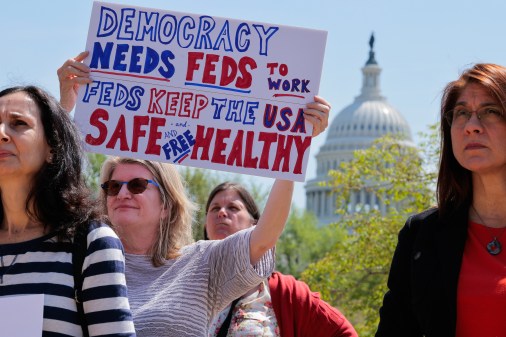‘Fully automated’ federal retirement feasible in next six months, OPM director says

As the Office of Personnel Management makes progress toward a long-pursued goal to move the government’s paper-based retirement system into the 21st century, its director said a “fully automated” process is about six months away.
“That’s not going to happen overnight,” OPM Director Scott Kupor said in an interview with FedScoop. But, Kupor said he believes the agency can get there within six months “for sure.”
The human capital agency hit a milestone in May with the launch of its Online Retirement Application, operationalizing a yearslong development effort and marking the end of paper file submissions. Yet behind the scenes at OPM, there’s still much work to do to bring about a truly automated process.
Though the application submissions are now online, humans still currently check the information coming in to make sure they’ve been completed properly and manually key in information into a calculator in “a significant number of cases,” Kupor said. That introduces “a huge amount of delay in the system” and is something the agency is working to fix.
The aim is to ultimately have a system where the retiree, human resources, and the payroll provider all submit their information online and route that package electronically — not to a person in the agency’s retirement services division, but to a Digital File System that can fill in the application and do the calculations, Kupor said. Under that future process, he said, all individuals at OPM will be doing is reviewing and spot checking.
The simple target of what OPM is trying to do with retirement services, Kupor said, is to go paperless “as quickly as possible.”
While many priorities across government have changed from the Biden to Trump administrations, the modernization of the federal retirement system has remained a primary goal, getting early interest from DOGE. Despite an influx of retirements under the Trump administration’s incentivized programs to get workers to leave federal service and now a long government shutdown, OPM is making incremental progress toward that goal.
Coming soon
Several key developments to bring federal retirement closer to its end-goal are moving forward — with some nearing completion in the near future.
The biggest focus areas for OPM are working to integrate payroll providers across the government with the system and completing development on an automated calculator that can read and process the incoming information, Kupor said.
By the end of the calendar year, Kupor said his hope is that the agency will have major providers across government integrated with the system — though the shutdown could impact that timeframe.
As it stands, delays getting necessary historical payroll information from those providers can take 15 to 30 days, Kupor said. But once they’re integrated, the information will be sent electronically in a computer-readable format on day one, as opposed to the current process of sending PDFs.
He estimated that of the roughly five or six major payroll providers, only one is currently providing machine-readable information.
While OPM’s own retirement services work is not funded by appropriations and is therefore not impacted by the current lapse, the shutdown is impacting HR and payroll partners elsewhere in government.
“My goal was to have all that done by December 31st. I still hope — I still believe — that’s possible, but I think if something slips, that will slip as a result of the shutdown,” Kupor said of the payroll integration.
An automated calculator, called Janus, is similarly nearing the finish line.
Kupor called that project “very far along” and said he anticipates that the tool will be completed in the next month or two. FedScoop previously reported that Biden administration officials had made substantial progress on that element.
“We’re almost at the point where all the calculations can now be done automatically, instead of literally via an Excel spreadsheet that a retirement services person is using,” Kupor said, noting that the complexity of some cases is a challenge.
New updates
Smaller developments are advancing, too.
In the next couple of weeks, Kupor said OPM will roll out a capability that will do more spot checking of each submission up front so people can’t file an application that hasn’t been vetted by the computer. That will eliminate a lot of what OPM refers to as “unhealthy” applications coming into the system, which will “save a lot of time,” Kupor said.
Last week, OPM also rolled out two updates to inch its progress forward: An easier way for annuitants to download 1099-Rs — a retirement-related tax form — without having to log into Retirement Services Online, and a new publicly available dashboard with estimated wait times for aspects of both the federal retirement and survivor benefit application processes.
According to Kupor, OPM has historically had to send 2 million paper copies of 1099-Rs to annuitants each year and requests for those forms drive a large portion of questions that OPM’s call center receives. “For the first time, now people can actually go online and just request their 1099-R from a secure portal,” Kupor said.
The dashboard, meanwhile, provides slightly more detailed information than previously available about application wait times, including the average time for receiving “interim pay” — a percentage of an annuitant’s expected total monthly retirement payout that’s provided as a stopgap while the process for receiving the full amount moves forward.
Those averages are meant to help avoid a situation where annuitants feel like “things are going to a black hole” and they “don’t know what’s happening,” Kupor said.
Per the September 2025 figures available upon publication of this story, the current wait time for interim pay was 14 days, which a spokeswoman said is in line with historical figures, and immediate retirement was 76 days, which is roughly two weeks longer than the agency’s goal of 60 days.
Good signs
John Hatton, the vice president of policy and programs at the National Active and Retired Federal Employees (NARFE), told FedScoop that both of those updates appeared to be positive steps.
“We’ve been frustrated with the processing times at OPM for a long time because of the paper-based process, so to see it move in this more modern direction and the transparency here is a good sign,” Hatton said of the updates.
On the 1099-R capability, he noted that NARFE “definitely” has members who have struggled to get into the Retirement Services Online system, particularly after the platform added Login.gov access — the government’s single sign-on solution.
“If all they need to do is look for a 1099-R and this makes it easier for them to do that, that’s great,” he said. Though, he added, it’s too early to tell if the new 1099-R’s capability would be helpful.
Hatton also welcomed the wait times dashboard.
While he noted that OPM has a history of routinely posting average monthly processing times, the interim pay- and survivor benefits-specific figures are new. On interim pay specifically, Hatton said that with the volume of retirements under the current administration, NARFE has been concerned about people getting at least those payments as quickly as possible.
“It’s frustrating to wait for your full retirement,” Hatton said. “It’s even more frustrating to wait if you don’t get any retirement coming in.” Interim pay is the “first step in the process where you start getting some form of annuity,” he said.
Interim pay
Kupor similarly emphasized the importance of interim pay as the government deals with the volume of retirements, and said the agency has been working to get as many people those checks as quickly as possible.
As the system is in a period in between fully and partially automated, Kupor said, the changes to interim pay are “the most important thing in the short term” the agency can do to “substantially minimize any disruption that people have in terms of their getting a check.”
Historically, Kupor said OPM has been able to get about 30% of people on “automatic” interim pay, which means they’re getting their first partial retirement payments in a week to 15 days. According to an OPM spokeswoman, the agency has been able to get the share of workers automatically getting those payments up to 75% — meaning a human is not touching it.
The remaining non-automatic portion of those annuitants, currently, has a complicating factor, such as a divorce, that needs a human to review and process. But the goal is to get as close to 100% of people into the automatic process as possible, Kupor said.
“The whole purpose there is we just recognize that, obviously — given the volume of applications we have — we know it’s going to take us a little bit longer to get the final pay for people,” Kupor said.






